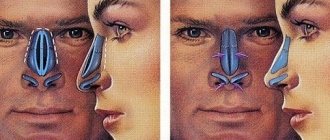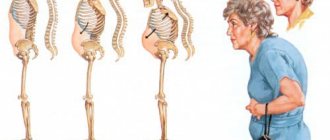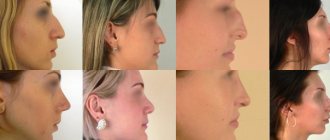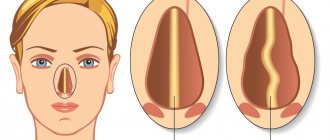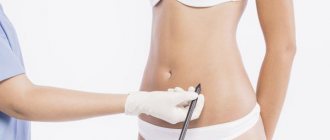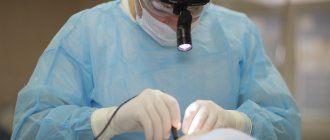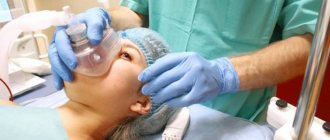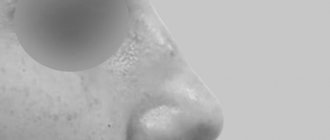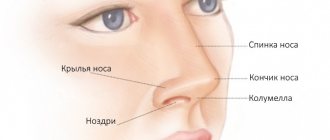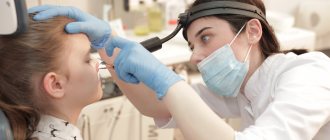After plastic surgery on the nose, patients complain of stuffiness. It occurs both after aesthetic (correction of defects) and after septoplasty (correction of the nasal septum). The nose begins to breathe differently in all patients. For some, on day 3-4, for others, by the end of the third week. Why this happens and what to do in case of prolonged recovery of breathing after rhinoplasty, we will tell you in this article.
Previously, after rhinoplasty, plastic surgeons inserted twisted sterile bandages - turundas - into the nasal passages. It was very painful to remove them from there, and I had to breathe through my mouth. Now the rehabilitation tactics have changed, and hollow silicone splints are used to maintain the shape of the nose. Their advantage is that air circulates through them. They are more elastic and durable, better retain the new shape of the nose and are not subject to mechanical deformation.
Rhinoplasty result before and after. Photo from the website of D.R. Grishkyan. There are contraindications, consultation with a specialist is required. Result of rhinoplasty Before and After. Photo from the website of D.R. Grishkyan. There are contraindications, specialist consultation is required
But despite this, nasal breathing may be difficult in the first week after surgery. There are natural reasons for this:
1. Internal swelling, which disappears after 7 days.
In our clinic, after rhinoplasty, a special splint is applied, and not a plaster cast, as in the old days. They leave no bruises or external swelling. Patients wear the splint for 7 days.
2. Formation of sap and drying of blood in the nose.
3. Dry mucous membranes.
Rhinoplasty result before and after. Photo from the website of D.R. Grishkyan. There are contraindications, consultation with a specialist is required. Result of rhinoplasty Before and After. Photo from the website of D.R. Grishkyan. There are contraindications, specialist consultation is required
When to see a doctor if breathing has not returned after rhinoplasty
After rhinoplasty, you must strictly follow the developed rehabilitation plan. In the first 3-4 days there will be difficulty breathing - this is the norm, so no measures need to be taken.
On the 7th day, when the splint is removed and the splints are removed. Many patients note that breathing becomes more free, but for 3 weeks they may still experience difficulty breathing. At this time, the doctor may prescribe medications that have anti-inflammatory and wound-healing properties.
After 3 weeks, swelling decreases by 80%. Therefore, in the period from 3 weeks to 3 months, patients may continue to complain of nasal congestion, absence or decreased sense of smell. By the end of the 3rd month, the sense of smell begins to recover. Complaints of difficulty breathing remain in 15% of patients.
https://www.instagram.com/p/CVfmlAZjDWg/
Breathing is restored within 2 weeks
Those who need septoplasty should take the choice of a clinic and doctor very seriously. The operation must be performed by an experienced otolaryngologist with the necessary knowledge and skills.
– On the one hand, this operation is simple and quite routine. But at the same time, the surgeon has no right to make mistakes. One wrong move is enough to damage the nasal septum, piercing it right through,” explains Elmira Mannanova. – This is fraught with bleeding and other problems, even changing the shape of the nose.
This is why it is so important to find a doctor you can truly trust. In this regard, the Mart clinic will probably be an ideal choice, because otolaryngologists here are literally “tailored” to operations related to the nose. And most importantly, the result is really worth it: after 2-3 weeks, normal breathing is restored, the person begins to distinguish more odors, and the frequency of headaches decreases.
You can make an appointment at the Mart clinic by calling 8 (843) 202-36-16. Here you will be helped to solve any problem related to the ENT organs
Complications after rhinoplasty
Difficulty breathing, which may continue after the recovery period, may be caused by complications. The reasons for this may be:
1. Postoperative violations of the structure of the nasal septum. Some patients may develop a septal deformity. This happens in the event of a mistake on the part of the plastic surgeon, or in the case of a violation of the rehabilitation plan on the part of the patient.
2. Secondary hypertrophy of the mucous membranes. The reason for this is often the excessive use of vasoconstrictor drops.
Rhinoplasty result before and after. Photo from the website of D.R. Grishkyan. There are contraindications, consultation with a specialist is required. Result of rhinoplasty Before and After. Photo from the website of D.R. Grishkyan. There are contraindications, specialist consultation is required
Nose care after septoplasty
The first two days after the operation, the patient remains in the hospital under the supervision of a doctor. During this period, the patient cannot breathe through the nose, since special gauze swabs are installed in the nasal cavity to promote proper fusion of cartilage and bone and prevent the development and suppuration of a postoperative hematoma. True, today there are also modern tampons with a tube inside through which the patient can breathe, but these channels must be regularly cleaned of mucus and crusts. This is much more convenient, since it is extremely uncomfortable to breathe only through your mouth for several days. The patient is prescribed strict bed rest and a strict diet.
After discharge from the ENT hospital, care after septoplasty for the nasal cavity, or rather, its control and responsibility, falls on the shoulders of the patient himself. The ENT surgeon, for his part, must alert the patient to the importance and seriousness of the postoperative period. The patient needs:
- conduct follow-up visits to your ENT surgeon once every two to three days to monitor the dynamics of the condition;
- be sure to promptly change the sterile cotton swabs placed in the nasal passages, which is especially important in the first postoperative days;
- two to three weeks after surgery, carry out mandatory nasal rinsing. Saline solutions are used to clean the nasal cavity (you can prepare them yourself, or it is better to buy ready-made ones from pharmacies). This cleansing of the nose helps relieve swelling and make breathing easier.
- cleaning the nasal passages from crusts is a consequence of dried blood clots. If they are not removed, breathing will become extremely difficult. For cleaning, you can use regular saline solution, which is instilled into the nasal passages, and cotton swabs, which are used to directly remove them. But this can only be done superficially. Deep cleansing is carried out only by an ENT doctor.
- The recovery period requires mandatory abandonment of bad habits:
- It is necessary to avoid high temperatures (exposure to the sun, baths, saunas, solariums), any physical activity, and temporarily stop wearing glasses.
| Medical service | price, rub. |
| Toilet of the nasal cavity after septoplasty | 1000 |
Special discount for Izhevsk residents
In addition to septoplasty, the Mart clinic offers another procedure to solve problems with nasal breathing. This is the so-called coagulation, or cauterization of the turbinates. Coagulation is often recommended for patients with vasomotor rhinitis, when nasal congestion occurs due to the constant use of vasoconstrictor drops.
“Don’t let the name of this procedure scare you,” says Elmira Mannanova. – It is performed under local anesthesia and lasts about 20 minutes, with most of this time spent on anesthetizing the patient. The doctor inserts a thin long electrode of a radio wave coagulator into the nasal concha, which affects the soft tissue within a few seconds. The nasal turbinates are reduced in volume, and after a couple of weeks the patient can breathe freely through the nose. The effect of coagulation lasts for several years if you follow all the recommendations of the otolaryngologist.
Until May 31, the clinic provides patients from Izhevsk with a 10% discount on all ENT surgery services
Attention! Until May 31 of this year, the Mart clinic provides a 10% discount on all ENT surgery services for all residents of Izhevsk and Udmurtia. Call and make an appointment.
You can read the original article at
Irrigation therapy: what is it and what is it for?
Irrigation means watering. A simple and effective method of irrigation therapy is a nasal douche. Why is this important?
Any, even minimally invasive, surgical intervention results in tissue damage, which leads to impaired blood supply, swelling and pain. The nutrition of the mucous membrane deteriorates, which leads to its dryness. And this provokes a violation of mucociliary clearance - the mechanism of self-cleaning of the respiratory tract, which is carried out by directed movements of the villi of the ciliated epithelium.
Stagnation occurs, which creates the preconditions for the development of inflammation and a purulent process. And since microorganisms and dust particles enter the nasal cavity from the external environment, the likelihood of infection is very high.
Nasal tamponade to stop bleeding additionally injures and dries the mucous membrane.
The solution to the problem is simple: a nasal shower with sea water at least every 4 hours. Solution concentration options:
- isotonic (0.085 - 0.9%) - the same concentration in the blood and tissues of the human body. Gently removes impurities, thins mucus, softens the scab of a surgical wound, kills bacteria, promotes tissue regeneration;
- hypertonic (up to 2.3%) - due to the higher salt concentration, the bactericidal activity and anti-edematous effect are more pronounced. The therapeutic effect is also stronger due to the greater number of trace element ions. However, some patients note irritation of the mucous membrane.
If you tolerate flushing with a hypertonic solution, then use it. For severe discomfort and irritation, use an isotonic solution.
Perforation
Perforation of the nasal septum is one of the complications of septoplasty.
If your nose does not breathe or makes a whistling sound when breathing, you experience dryness in the nasopharynx, or, conversely, observe purulent discharge, you need to urgently consult a doctor.
Such symptoms may indicate a violation of the integrity of the nasal septum. Most often, this complication is associated with a malnutrition of the cartilage. If this condition is not treated, the nose will become deformed, become saddle-shaped, and breathing difficulties will only increase.
Treatment of perforations is surgical. The doctor will close the defect with a flap cut from adjacent tissues and carry out the necessary treatment of the damaged cartilage.
Anatomy of the nasal septum
The nasal septum divides the nasal cavity into two parts, usually unequal in size and configuration due to its curvature. The nasal septum consists of bone and cartilaginous parts. The bony part is formed by the perpendicular plate of the ethmoid bone and the vomer. The perpendicular plate from above in front adjoins the frontal bone and the inner surface of the nasal bones, and behind and below it connects with the upper edge of the vomer. Between the anterior edge of the perpendicular plate and the anterior third of the vomer there is a quadrangular cartilage. The upper edge of the cartilage forms the anterior part of the dorsum of the nose. Adjacent to the anterior edge of the quadrangular cartilage is the medial peduncle of the greater alar cartilage. The cutaneous-cartilaginous, anterior part of the nasal septum, unlike the bone part, is mobile.
The air flow passing through both halves of the nose is asymmetrical. Most healthy people experience a cyclic change in resistance to air flow passing through the left and right halves of the nose (the so-called nasal cycle), but the total resistance remains constant. Alternating changes in air flow in both halves of the nose can be explained by the need for rest to restore the nasal mucosa from microtrauma and functional overload.
The physiological nasal cycle is possible only if the nasal septum does not have a pronounced deformation and is located in the midline. In the case of anomalies in the development of intranasal structures leading to asymmetry of the lumen of both halves of the nose (for example, curvature of the nasal septum), a high degree of resistance to the air flow is constantly created on the side of the narrowing, and the speed of the air stream increases. In this case, the bulk of the air goes through the wider half of the nose. Cyclic changes in resistance are disrupted. Due to constant functional overload, after several years, chronic rhinitis develops in the wider half of the nose, leading to a constant increase in resistance to air flow in the two halves of the nasal cavity.
Thus, the septum, dividing the nasal cavity into two halves, creates a pairing of the organ. Regulated by the nasal cycle, these organs (halves of the nose) function alternately at full load, periodically resting. Complete rest is possible only with the correct position of the partition.
